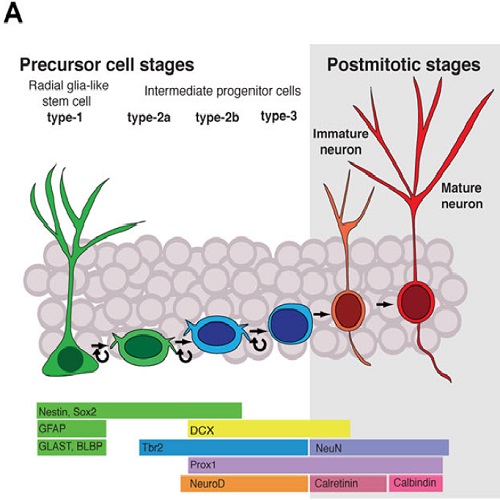Development of the adult neurogenic niche in the hippocampus of mice.
When does adult hippocampal neurogenesis begin? We describe the development of the neurogenic niche in the subgranular zone (SGZ) of the hippocampal dentate gyrus. We did so from the perspective of the situation in the adult. Ontogeny of the dentate gyrus is complex and results in an ectopic neurogenic niche that lifelong generates new granule cells. Neurogenesis during the fetal and early postnatal periods builds the dentate gyrus and gives way to activity-dependent "adult" neurogenesis. We used markers most relevant to adult neurogenesis research to describe this transition: Nestin, Sox2, BLBP, GFAP, Tbr2, Doublecortin (DCX), NeuroD1 and Prox1. We found that massive changes and a local condensation of proliferating precursor cells occurs between postnatal day 7 (P7), near the peak in proliferation, and P14. Before and around P7, the spatial distribution of cells and the co-localization of markers were distinct from the situation in the adult. Unlike the adult SGZ, the marker pair Nestin/Sox2 and the radial glial marker BLBP were not overlapping during embryonic development, presumably indicating different types of radial glia-like cells. Before P7 GFAP-positive cells in the hilus lacked the radial orientation that is characteristic of the adult type-1 cells. DCX, which is concentrated in type-2b and type-3 progenitor cells and early postmitotic neurons in the adult, showed diffuse expression before P7. Intermediate progenitor cell marker Tbr2 became restricted to the SGZ but was found in the granule cell layer (GCL) and hilus before. Lineage markers NeuroD1 and Prox1 confirmed this pattern. We conclude that the neurogenic niche of adult neurogenesis is in place well before true adulthood. This might indicate that consistent with the hypothesized function of adult neurogenesis in activity-dependent plasticity, the early transition from postnatal neurogenesis to adult neurogenesis coincides with the time, when the young mice start to become active themselves.
Back to list
